This Nutella babka features swirls of rich, chocolatey Nutella nestled in soft, pillowy, egg-free bread. It will make your kitchen smell like a European bakery and fill your heart with joy. This Nutella babka recipe is my go-to when I want to impress without fuss. It is deeply comforting, so easy, slightly indulgent, and unforgettable.
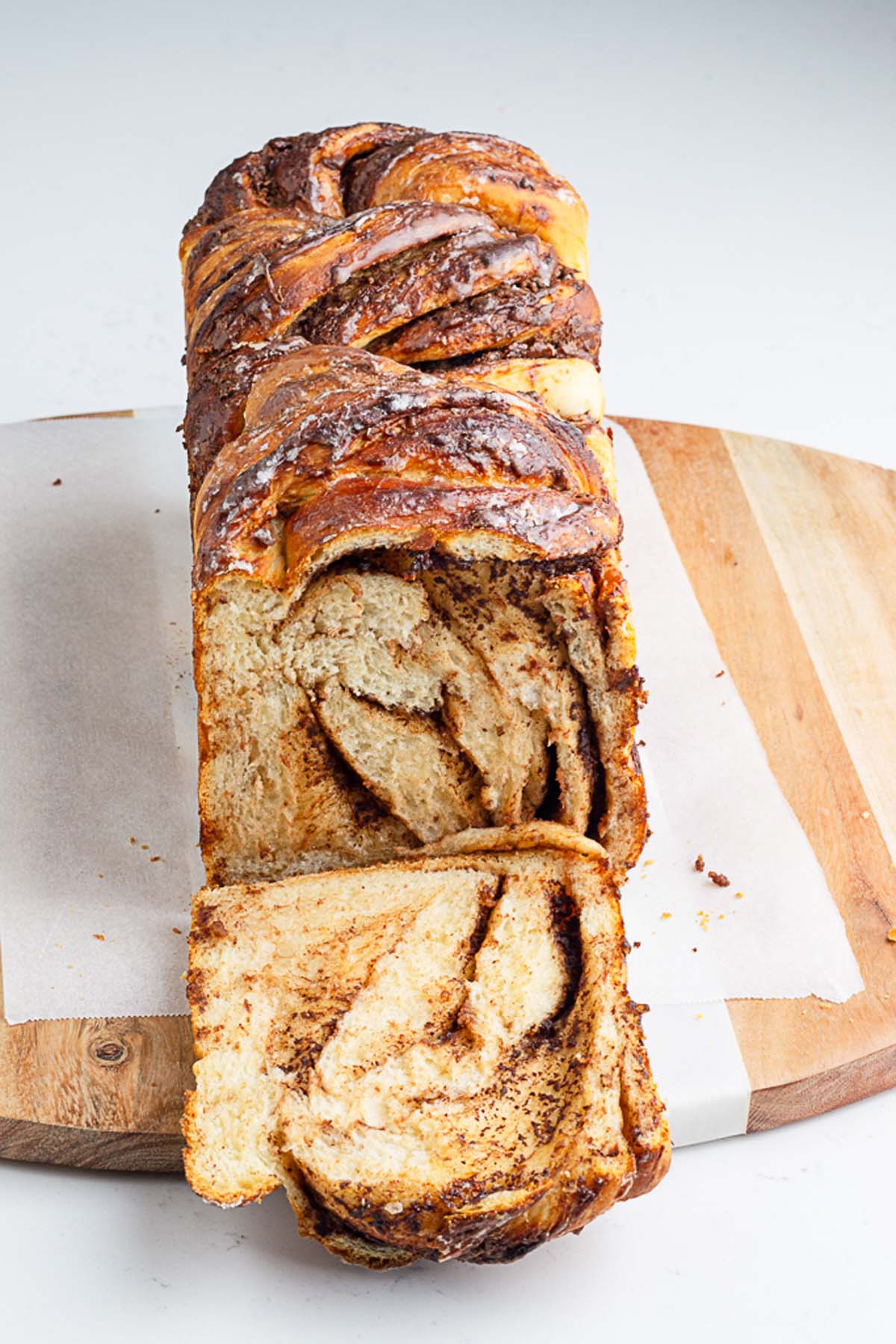
Jump to:
👩🏽🍳Why You’ll Love This Nutella Babka
- Bakery-style indulgence at home – Soft, fluffy dough with rich Nutella swirls that look as good as they taste.
- Beginner-friendly – No eggs, no complicated steps, and perfect for first-time yeast bakers.
- Made with simple pantry ingredients – No fancy tools or hard-to-find ingredients required.
- Versatile and freezer-friendly – Enjoy it fresh, toast leftovers, or freeze for later—still delicious!
- Perfect for any occasion – Ideal for brunch, gifting, or a cozy weekend treat with coffee.
- Guaranteed wow factor – That beautiful swirl and gooey center never fail to impress!
🧂Ingredient Notes for Nutella Babka
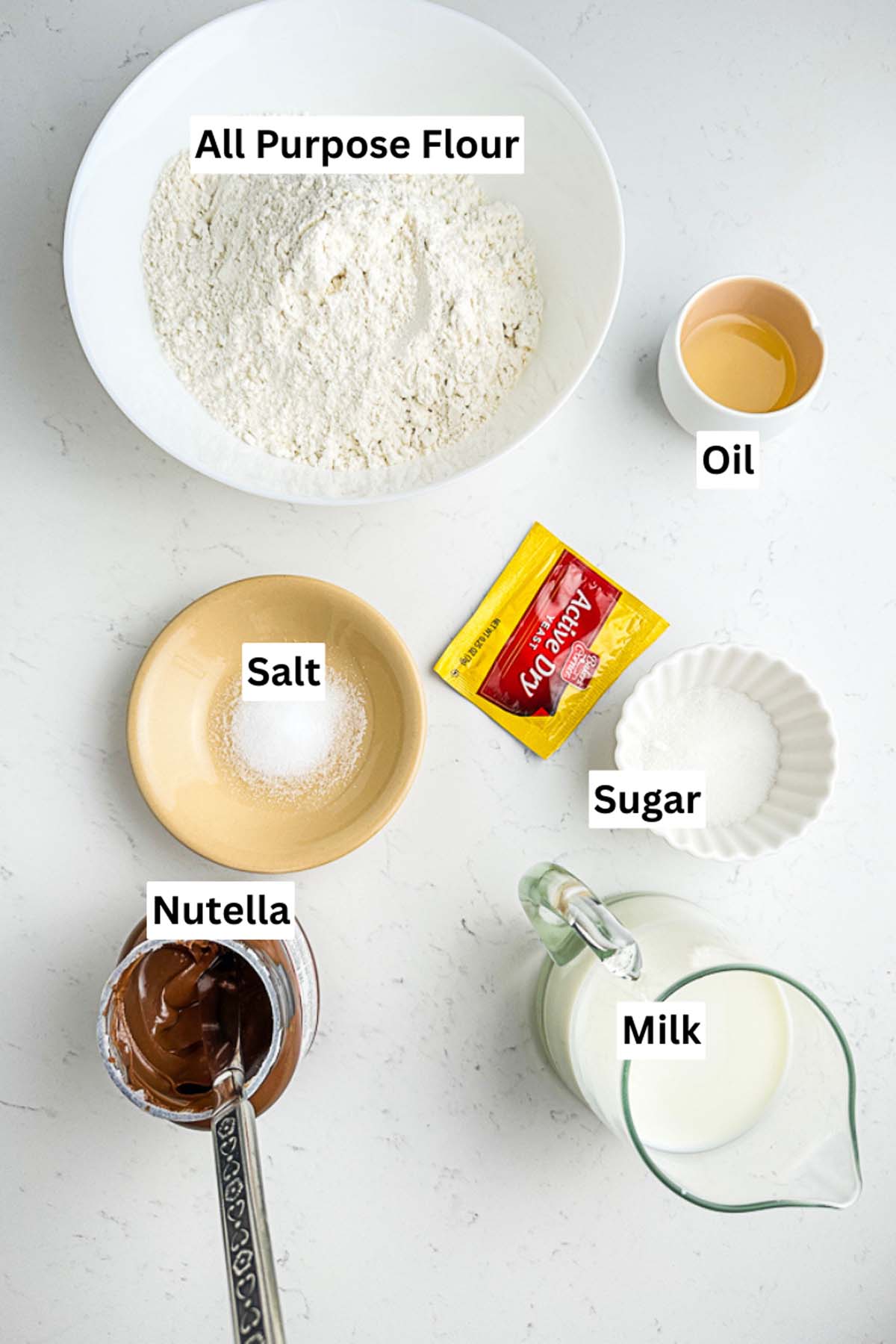
- All-Purpose Flour
I use regular all-purpose flour for this Nutella babka recipe, which gives a soft yet structured crumb. If you’d like a chewier texture, you can swap in 50–100g of bread flour. For a more wholesome version, replace up to 30% with whole wheat flour—just keep in mind the babka will be slightly denser. - Whole Milk
Whole milk brings richness and tenderness to the dough. You can substitute with 2% milk, but avoid skim milk as it lacks the fat needed for that soft, enriched texture. For a dairy-free Nutella babka, oat milk or almond milk (unsweetened) work beautifully. - Active Dry Yeast
I use active dry yeast, which needs to be activated in warm milk. If you’re using instant yeast, you can mix it directly into the flour—just use slightly less (about 5g). Always check your yeast's expiration date, as inactive yeast can lead to flat dough. - Oil or Unsalted Butter
It adds a subtle richness and helps create a soft, tender crumb. I personally prefer using a neutral-flavored oil, as it keeps the bread moist and tender even at cooler room temperatures—and yes, it's actually more enjoyable straight from the fridge compared to butter-based doughs. Butter-based breads tend to firm up when chilled, so they’re best enjoyed warm or at room temp. If you're using salted butter, that's totally fine—just reduce the added salt a little to balance the flavor. And for a vegan Nutella babka, simply swap in vegan butter or margarine—the results are still deliciously rich and fluffy! - Sugar
This small amount of sugar helps feed the yeast and adds a mild sweetness. You can use coconut sugar or maple syrup for a more natural sweetener, though it may slightly alter the flavor. - Salt
Salt enhances the overall flavor and balances the sweetness of the Nutella. Don’t skip it! If using salted butter, reduce the salt to about 3g. - NutellaNutella is the star of this babka—rich, chocolatey, and comforting. If you want to switch things up, try using a chocolate-hazelnut spread with cleaner ingredients or even a homemade Nutella. For a twist, swirl in peanut butter, tahini, or Biscoff spread instead.
🔪 Step-by-Step Instructions to Make Nutella Babka
Step 1: Activate Yeast
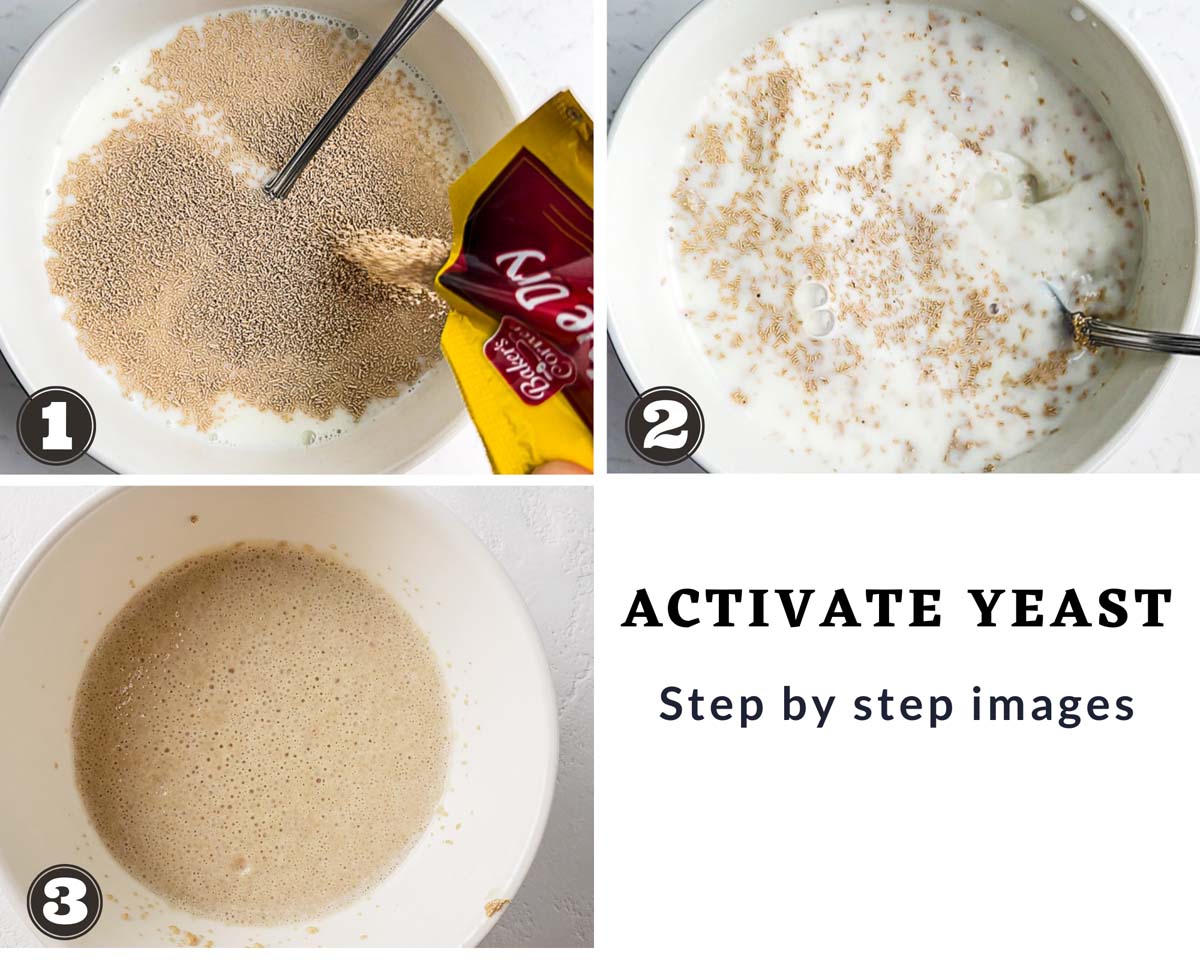
Start by warming the milk until it’s just lukewarm—think baby bath temperature. Sprinkle in the active dry yeast and a little sugar, then let it sit for about 5–10 minutes until it turns foamy. This tells you your yeast is alive and ready to go!
Step 2: Kneading dough
Kneading in a stand mixer
Knead the dough in a stand mixer using the dough hook attachment. After adding all your ingredients to the bowl, start on low speed for the first minute to bring everything together, then increase to medium speed and let it knead for 12-15 minutes.
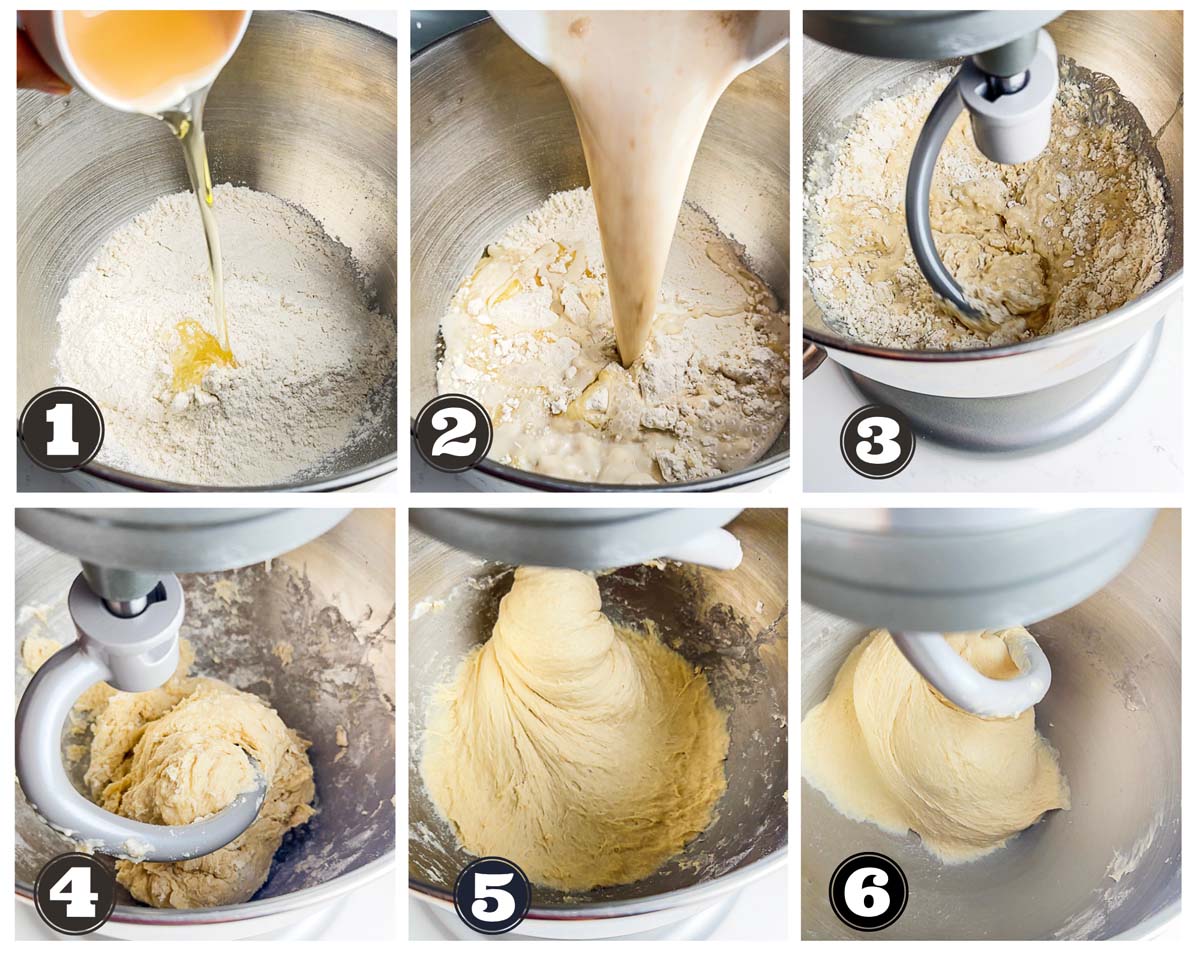
Keep an eye on the dough—it should start pulling away from the sides of the bowl and form a cohesive ball. If the dough seems too sticky after a few minutes, you can add a tiny sprinkle of flour, but be cautious not to overdo it. The goal is a soft, slightly tacky dough that feels stretchy and smooth. Once done, give the dough a quick poke; it should slowly bounce back. That’s your sign it’s ready for the first rise.
Kneading dough with hands
In a large mixing bowl (or the bowl of your stand mixer), combine all-purpose flour, remaining sugar, and salt. Add in the foamy yeast mixture and softened butter. Mix everything together until it forms a shaggy dough.
Start by pressing the dough away from you with the heel of your hand, then folding it back over itself, giving it a quarter turn each time. This rhythmic push, fold, and turn motion helps develop gluten, which gives the babka its soft yet chewy texture. The dough will be sticky at first—resist the urge to add too much extra flour! A bench scraper can be really handy here. After about 10–12 minutes, the dough should become smooth, elastic, and slightly tacky but no longer sticky. You’ll know it’s ready when you can stretch a small piece thin enough to see light through it (the “windowpane test”).
Step 3: First Rise ( Bulk Fermentation)
Transfer the dough to a lightly oiled bowl and cover it with a damp cloth or plastic wrap. Let the dough rise in a warm spot for about 1.5 to 2 hours, or until it has doubled in size. If your kitchen is chilly, place the bowl in the oven with just the light on for a cozy proofing environment.
Once the dough has doubled in size, I like to chill it in the fridge for 2–3 hours. This step is optional, but it makes the dough much easier to handle and shape. If you don’t mind a slightly stickier dough, feel free to skip it!
Step 4: Shape the Babka
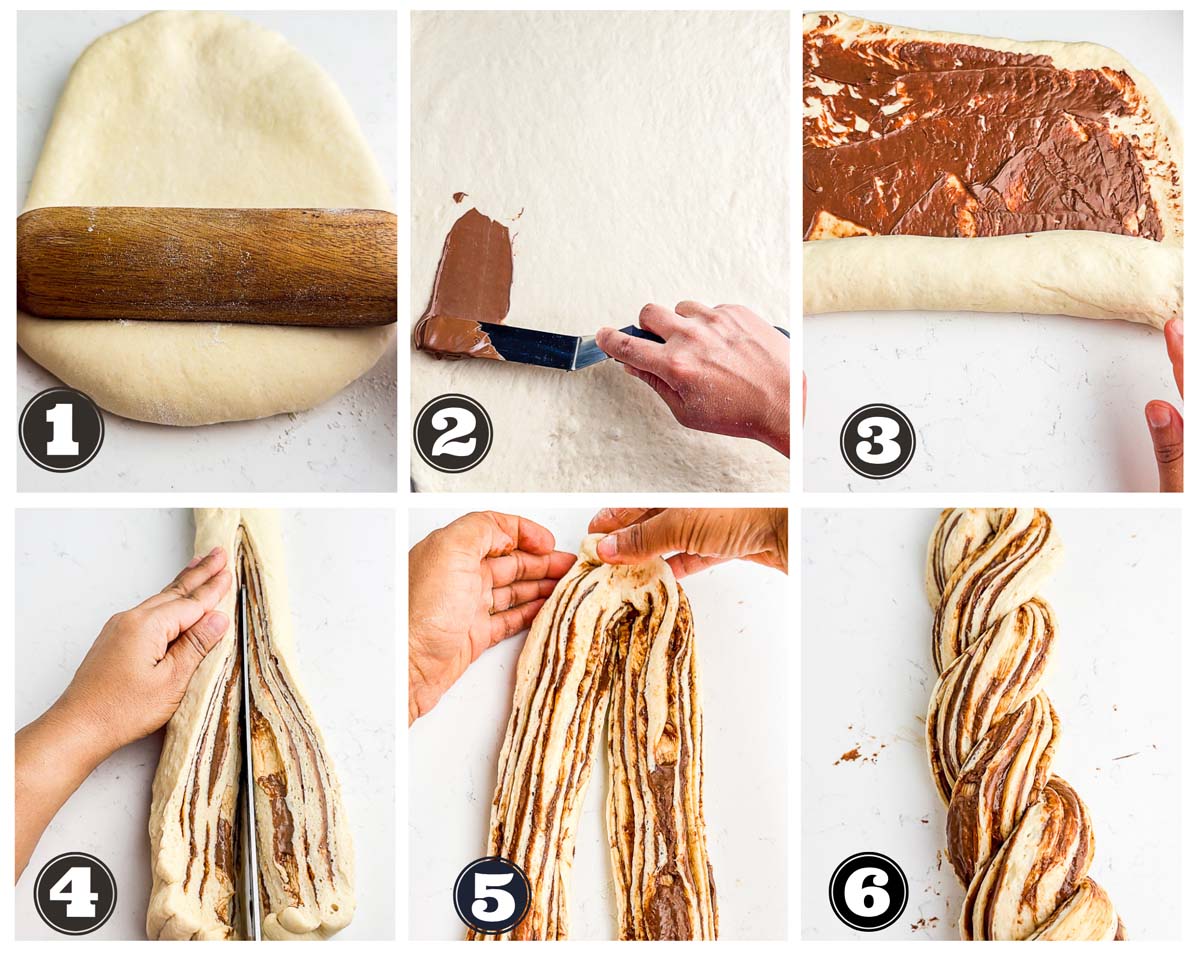
Once the dough has doubled, punch it down gently to release the air. Roll it out on a lightly floured surface into a rectangle about ¼ inch thick. Spread a generous layer of Nutella all over the dough, right to the edges. But leave a small border on one of the long sides to help seal it later.
Starting from the long edge, roll the dough tightly into a log, like you would with cinnamon rolls. Place it seam-side down. Now, use a sharp knife to slice the log in half lengthwise, exposing those gorgeous Nutella swirls.
Now, twist the two halves together, keeping the cut sides facing up. Don’t worry if it looks messy. It bakes into a beautiful, rustic pattern. Carefully transfer the twisted babka into a greased loaf pan. I used a 9x4.5-inch Pullman loaf pan. But anything around this size would work.
Alternative shaping options
- You can also shape it into a babka wreath and bake on a baking sheet lined with parchment paper if you don’t have loaf pans of the appropriate size on hand.
- You can easily turn this recipe into Nutella babka buns for a fun, individual-sized twist. Start by dividing the dough into equal portions, then roll, fill, split, and twist each piece just like the full-sized version. Place the shaped babka buns into greased muffin tins, let them proof until puffy, and bake until golden and fragrant.
Pro Tip: Chill the dough before shaping to make the process easier, neater, and mess-free.
Step 5: Final Rise
Cover the pan loosely with a cloth and let the shaped babka rise again for 45–60 minutes, until it looks puffy and relaxed. This final proof helps give the babka its signature light texture.
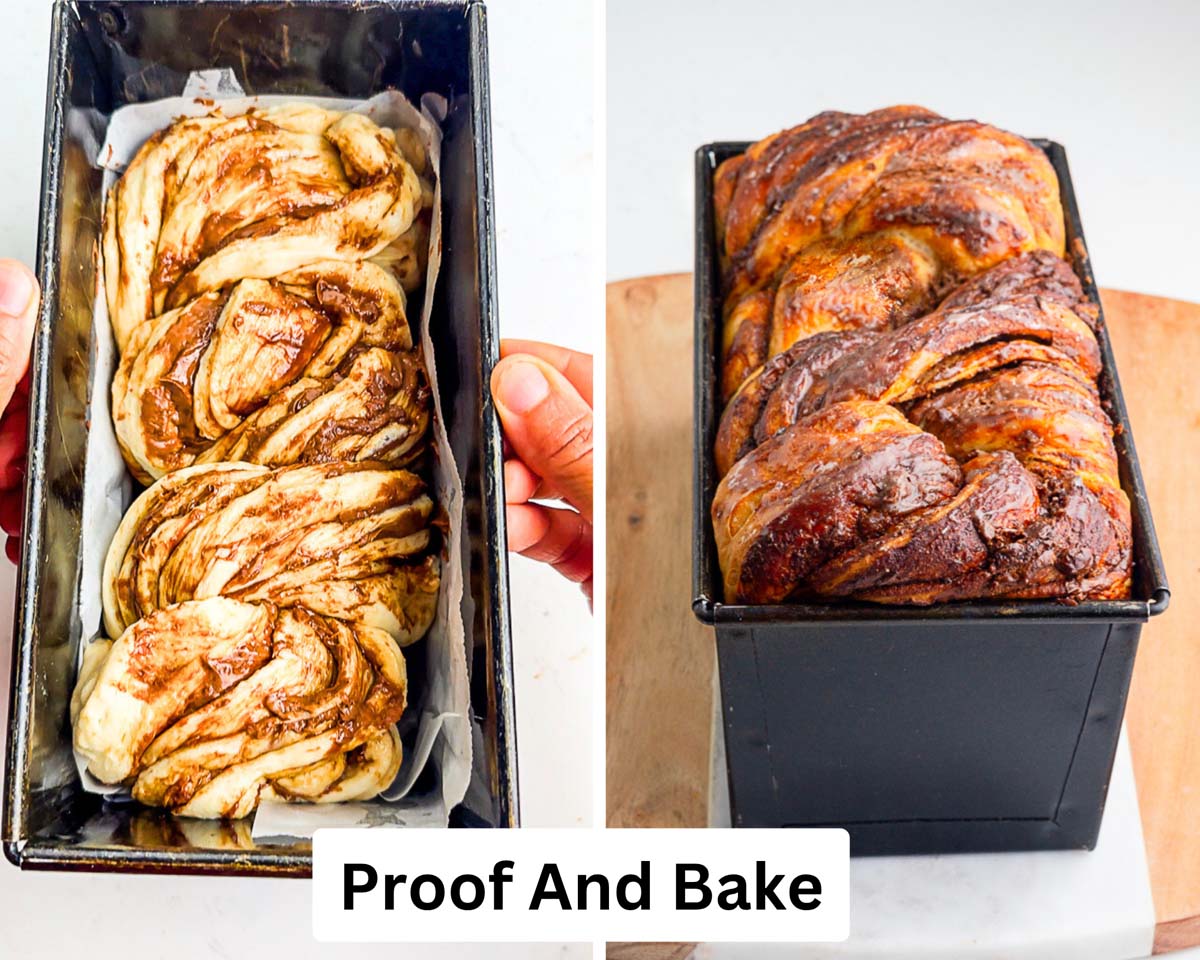
Step 6: Bake the Babka
Preheat your oven to 350°F (180°C). Once the babka has risen, bake it in the center of the oven for about 30–32 minutes, or until the top is golden brown and the loaf sounds hollow when tapped.
If it starts browning too quickly, tent it loosely with foil during the last 10 minutes of baking.
Step 7: Cool & Enjoy
For extra softness and shine, brush the freshly baked babka with a simple sugar syrup. This step is optional, but it helps keep the loaf moist for longer. To make it, just combine equal parts sugar and water.
For this recipe, 3 tablespoons of sugar and 3 tablespoons of water work perfectly. Bring it to a boil, then turn off the heat and let it cool slightly before brushing it over the warm babka.
After baking, let your Nutella babka cool in the pan for 10–15 minutes, then gently transfer it to a wire rack. It’s incredibly tempting to slice into it while it’s still warm. And honestly, I wouldn’t blame you if you did!
This homemade Chocolate Nutella babka is perfect for breakfast, brunch, or an indulgent afternoon snack. Leftovers (if you have any!) taste amazing lightly toasted the next day.
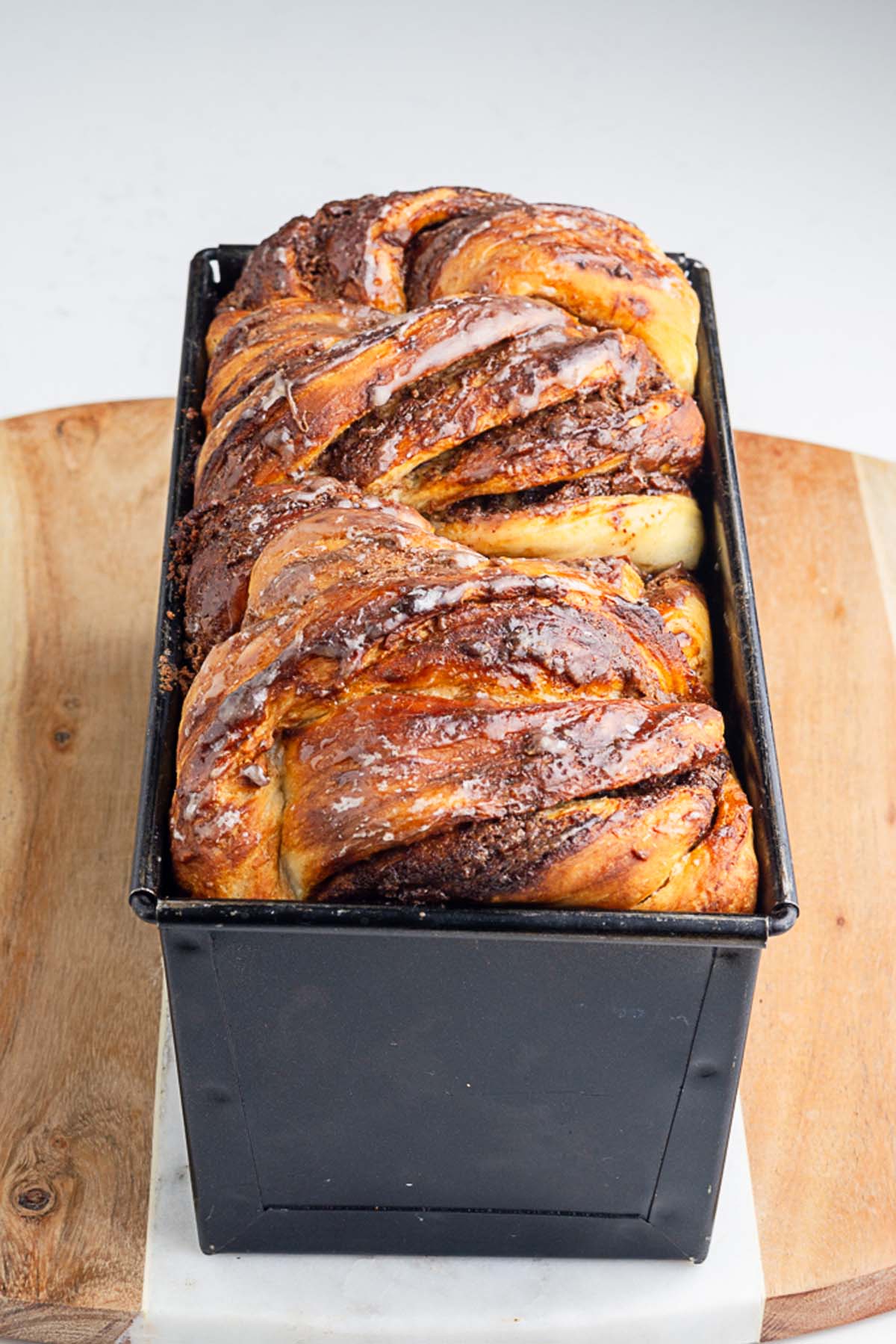
💡Helpful Tips for Baking the Perfect Nutella Babka
- Wondering how to get those neat swirls without the mess? Try popping your dough in the fridge for a couple of hours once it has risen. Chilling makes it easier to make babka with Nutella. It is easy to roll, twist, and shape, especially when working with a gooey Nutella filling.
- That irresistible glossy finish? A light brush of simple syrup right after baking does the trick. It locks in moisture and adds a bakery-style sheen. I’ve even used maple syrup at times, and trust me, it works beautifully!
- Using active dry yeast? Always proof it in warm milk (not hot!) with a pinch of sugar until it becomes foamy. This is your sign that the yeast is alive and ready. If you’re using instant yeast, you can skip the proofing step and mix it directly into the flour; just use a slightly smaller amount.
- Avoid over-flouring the dough! It’s supposed to be soft, supple, and a bit sticky. Adding too much extra flour while kneading, especially by hand. It can result in a dry or dense loaf. Use a bench scraper instead to help manage stickiness.
- No dairy? No problem! Swap the whole milk with oat, almond, or soy milk, and use vegan butter or even coconut oil instead of regular butter. Your babka will still come out rich, tender, and full of flavor.
- Not a Nutella fan or need a variation? You can use a refined sugar-free chocolate hazelnut spread, or change things up completely with cookie butter, peanut butter-chocolate, or even spiced cinnamon-sugar filling for a twist on tradition.
- Twist with confidence! Babka’s charm lies in its rustic swirls, so don’t stress over perfection. If your filling feels too soft and starts to ooze out while shaping, a quick chill will firm it up and make shaping a breeze.

🔗More Indulgent bread recipes
- Monkey Bread
- Senorita bread
- Brioche cinnamon rolls
- Sheermal
- Ube Cinnamon rolls
- Challah Bread
- Chocolate buns
- Coffee Buns
This homemade Nutella babka recipe is more than just a bread. It's a swirl of joy, nostalgia, and indulgence in every bite. If you try it, I’d love to hear how it turned out—leave a comment or tag me on Instagram so I can see your delicious creations!
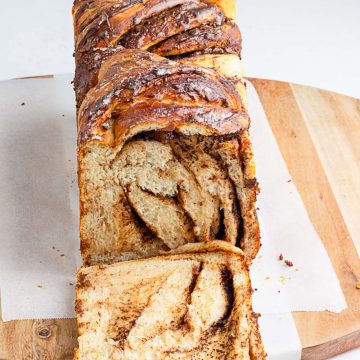
Nutella Babka
Ingredients
- 400 g all-purpose flour (≈ 3 ¼ cups)
- 285 g whole milk (≈ 1 ⅕ cups)
- 6 g active dry yeast (≈ 2 tsp)
- 20 g oil (or unsalted butter) (≈ 1 ½ tbsp)
- 12 g sugar (≈ 2 tsp)
- 6 g salt (≈ 1 tsp)
- Nutella – approx. ⅓ cup (use as needed for filling, about 100–110 g)
Instructions
Step 1: Activate the Yeast
- Warm the milk until just lukewarm (like baby bath temperature).
- Stir in active dry yeast and a little sugar.
- Let it sit for 5–10 minutes until foamy. This confirms the yeast is active.
Step 2: Knead the Dough
- Kneading with a Stand Mixer* Into a bowl of the stand mixer, add flour, salt, remaining sugar, foamy yeast mixture, and oil. Put the dough hook attachment.*Start kneading on low speed for 1 minute, then increase to medium and knead for 12–15 minutes.*Dough should pull away from the sides and form a smooth, stretchy ball.*If too sticky, add a light sprinkle of flour—don’t overdo it.* Poke test: dough should slowly spring back when ready.
- Kneading by Hand* Mix flour, salt, remaining sugar, foamy yeast mixture, and oil to form a shaggy dough.* Knead using a push-fold-turn motion for 10–12 minutes.* Dough will be sticky at first—avoid adding too much extra flour.*Use a bench scraper to help manage stickiness.* Finished dough should be smooth, elastic, and slightly tacky.* Test readiness with the windowpane test (stretch dough thin enough to see light through it).
Step 3: First Rise (Bulk Fermentation)
- Place dough in a lightly oiled bowl; cover with plastic wrap or a damp cloth.
- Let rise in a warm spot for 1.5 to 2 hours or until doubled in size.
- If your kitchen is cool, place it in the oven with the light on for gentle warmth.
- Optional but helpful: Chill the dough for 2–3 hours after rising to make shaping easier and mess-free.
Step 4: Shape the Babka
- Gently punch down the risen dough and roll into a rectangle (~¼ inch thick) on a floured surface.
- Spread Nutella evenly, leaving a small border on one long edge.
- Roll into a tight log from the long side, seam side down.
- Slice the log in half lengthwise to expose the filling.
- Twist both halves together, keeping cut sides facing up.
- Transfer the twisted dough into a greased 9-inch loaf pan.
- Pro Tip: Chill the dough before shaping for a neater, easier process.
Step 5: Final Rise
- Cover the shaped babka loosely with a cloth.
- Let rise for 45–60 minutes until puffy and relaxed.
Step 6: Bake the Babka
- Preheat oven to 350°F (180°C).
- Bake for 30–32 minutes, until golden and hollow-sounding when tapped.
- If browning too fast, tent loosely with foil during the last 10 minutes.
Step 7: Cool & Enjoy
- Optional: Brush with simple syrup while warm to keep moist and add a glossy finish.
- Let cool in the pan for 10–15 minutes, then transfer to a wire rack.
- Slice and enjoy warm.
Notes
- First, make sure your yeast is active—this might sound basic, but inactive yeast is one of the most common reasons for babka that doesn’t rise properly. Always proof it in warm (not hot) milk until foamy before proceeding. If you’re using instant yeast, you can skip the proofing step and add it directly to the flour, but reduce the quantity slightly.
- The dough should be slightly sticky but manageable, especially if you're kneading by hand. Resist the urge to "fix" sticky dough with extra flour—it’s meant to be soft and hydrated for the best texture.
- For a dairy-free Nutella babka recipe, you can easily substitute whole milk with almond, oat, or soy milk, and use vegan butter or coconut oil in place of regular butter. The flavor will still be rich and satisfying.
- If you're looking to avoid Nutella due to dietary restrictions or simply want variety, try swapping it with a chocolate hazelnut spread with no added sugar, or go for fun alternatives like cookie butter babka or peanut butter and chocolate swirl babka.
- When rolling and twisting the dough, don’t worry if it looks messy—that rustic, swirled look is what gives babka its charm! However, if your filling leaks out while twisting, try chilling the dough slightly before shaping. This helps the spread firm up and makes it easier to handle.
- Once the dough has doubled in size, choose to chill it in the fridge for 2–3 hours. It makes the dough much easier to handle and shape
- Brush the freshly baked babka with simple sugar syrup to help keep it moist for longer. I have used maple syrup to brush babka on multiple occasions, and I can tell from my experience that it works really well.
Nutrition
🫙🔥 Storage & Reheating Instructions
Nutella babka stays soft and delicious for days—if it lasts that long! Once fully cooled, store the babka in an airtight container at room temperature for up to 3 days. To keep it extra fresh, wrap it tightly in plastic wrap or aluminum foil. If your kitchen is humid, it's best to refrigerate it and reheat slices before serving.
For longer storage, Nutella babka freezes beautifully. Wrap the whole loaf or individual slices in plastic wrap, then a layer of foil, and freeze for up to 2 months. When you’re ready to enjoy, just thaw it at room temperature for a few hours.
To reheat, pop a slice in the microwave for 10–15 seconds or warm it in the oven at 160°C (320°F) for about 5–7 minutes. It brings back that just-baked aroma and melty Nutella goodness—perfect with a cup of coffee or tea.
❓Frequently Asked Questions
A dry or dense babka is usually the result of over-flouring, under-proofing, or over-baking. One common mistake is adding too much flour during kneading—Nutella babka dough is supposed to be slightly sticky and soft. Adding excess flour to make it easier to handle can lead to a dense texture.
Another culprit is insufficient proofing time. The dough needs to double in size during the first rise and should look puffy and relaxed before baking; otherwise, it won’t have enough airiness.
Finally, overbaking can cause dryness—always check for doneness around the 30–35 minute mark and cover the loaf with foil if it's browning too quickly. For best results, use a thermometer: the internal temperature should be around 190–195°F (88–90°C) when done.
Yes, Nutella babka is very freezer-friendly, and you can definitely make it ahead of time! After shaping the babka (just before the final rise), you can cover the loaf pan tightly and refrigerate it overnight. This slow fermentation deepens the flavor and is a great make-ahead option for busy mornings. When ready to bake, let it come to room temperature and proof for about 45–60 minutes before putting it in the oven.
To freeze, bake the babka fully and allow it to cool completely. Then wrap it tightly in plastic wrap and foil and freeze for up to 2 months. To serve, thaw it at room temperature and warm it slightly in the oven for that freshly baked feel. You can also freeze individual slices wrapped in parchment for easy snacking!
Absolutely! While Nutella is a classic and indulgent filling, babka is incredibly versatile. There are numerous ways to make babka recipes. Customize it to suit your taste or what you have on hand. Some delicious alternatives include dark chocolate spread, homemade hazelnut paste, cinnamon sugar with butter, Biscoff cookie butter, or even peanut butter and jam for a nostalgic twist.
For a more refined flavor, try tahini and honey, or pistachio paste with white chocolate. I am also seeing a lot of strawberry babka lately, all over the internet. Just make sure your filling is spreadable and not too runny, as overly wet fillings can leak out and affect the dough's texture.
When switching fillings, adjust the sweetness of the dough accordingly if needed.


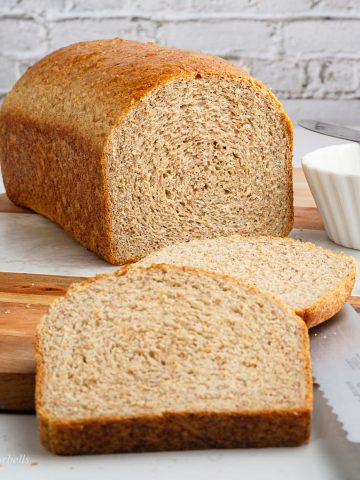
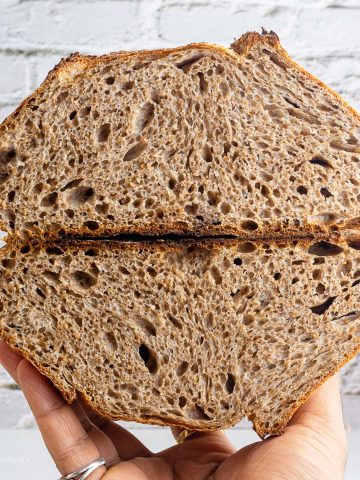


Leave a Reply